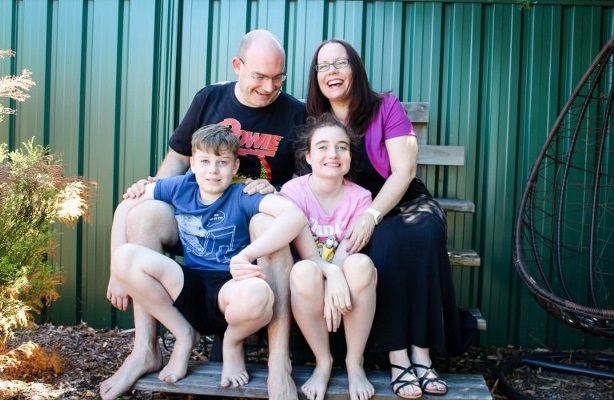Sensory rooms and sensory friendly inclusive design
Co-designed with Disability Inclusion Consultant Samantha Rowe
-(1).png?sfvrsn=dc4dc6fc_1)
Samantha (Sam) Rowe (she/her) is an intersectional disability advocate, disability inclusion consultant and researcher with lived experience of Autism, ADHD, and a neurological disability. She brings both professional and personal insight to her cultural sector research and inclusion work, with a strong focus on sensory sensitivity inclusion.
Sam undertook accessibility and advocacy work and research at the University of Queensland, UQ Art Museum, Ipswich Libraries, and currently with Griffith University. Sam’s consultancy work outside of the cultural sector includes co-design projects with Queenslanders with Disability Network, consumer representative work, and advisory and reference group work.
This resource, and others in this series focusing on sensory sensitivity inclusion, was co-designed with Sam.

What are sensory rooms?
Sensory rooms are spaces or rooms in buildings - often public spaces - that provide visitors with sensory sensitivity a safe space to go-to to decompress during their visit. They are designed to support individuals who experience sensory overwhelm and help them regulate their over or under stimulation. The use of sensory rooms has been increasing over time, but is by no means universally available.
There are two different types of sensory rooms that may be available; sensory calming rooms or multi-sensory rooms.
- Sensory calming rooms (also known as low sensory rooms, reset rooms, quiet rooms, chill out spaces, sensory spaces or Snoezelen rooms) are low sensory designed environments that assist those experiencing sensory overwhelm to decompress. They can include designs such as neutral lights and colour palettes, climate control, and AT such as earmuffs, fidget items and other sensory calming items.
- Multi-sensory rooms are designed with a variety of sensory stimuli to engage those who are sensory seeking. They can include AT such as music, projections, bubble tubes, lights, and fidget tools, as well as other interactive items such as colouring-in and other craft activities.
It is important to note that as no two people are the same, the ideal design of a room for sensory sensitivity differs for each individual, and so elements of user control should be considered. This can include adjusting sound volume, light brightness, being able to turn projections and lava lamps off, a variety of seating options and a range of activities to suit different age ranges.
Why are they needed?
People who experience sensory sensitivity can find public spaces overstimulating and stressful. Individuals may find themselves excluded and isolated, which can have multiple negative effects. Providing safe spaces for people with sensory sensitivity to visit when they need to, enables them to engage and participate in society on an equitable level.
Some sensory calming spaces available are aimed specifically for autistic individuals. However, sensory sensitivity is experienced by a range of health conditions, and so need to be available for anyone who experiences sensory sensitivity – including any accompanying friends, family and carers.

Examples of sensory rooms
WA
- Perth Airport: Sensory Room | Perth Airport
- Optus Stadium: Sensory Room
- Fremantle Doctors Football Club: Official AFL Website of the Fremantle Dockers
- University of WA: Inclusive spaces - The University of Western Australia
NSW
- Sealife: Making Magic Accessible - Our Sensory Room Unveiled
- Macquarie University: Sensory space - Macquarie University Sydney
- University of Wollongong: Early Start Discovery Space
- University of New South Wales: Neutral sensory study spaces at Main Library
Victoria
- Marvel Stadium: Sensory Room
- Melbourne Cricket Ground: Sensory Friendly Space
- John Cain Arena: Inglis Family Sensory Room
Queensland
- Pine River Gallery: Quiet Hour Galleries
- Rockhampton Gallery: Quiet Space
- Suncorp Stadium: Quiet Room
South Australia
- Adelaide Oval: Sensory Space
- Adelaide Entertainment Centre: Sensory Room
- Flinders University: Sensory Spaces
Australian Capital Territory
- Tamar Community Access Hub: Sensory Room
List of public reset rooms from Amaze: Find a Public Reset Room - Amaze
AT found in sensory rooms
- Earmuffs / noise cancelling headphones
- Fidget items
- Weighted blankets
- Sunglasses
- Communication cards
AT that could be found in multi-sensory rooms:
- Bubble Tube
- Fiber Optics
- Liquid Floor Tiles
- Projector and Interactive Lighting
- Interactive Infinity Panel
- Therapy Rocker
- Space Tube
- Bean Bag
- High Back Swivel
- Pod Chairs
- Echo/Acoustic Panel
.png?sfvrsn=3f52255e_0)
.png?sfvrsn=755616be_1)
What is sensory friendly inclusive design?
Sensory friendly inclusive design acknowledges that these barriers are an everyday experience for many people and suggests changing the way that public and private spaces are designed. Designing spaces that are inclusive and accessible to many different types of disabilities provides inclusive environments where everyone can participate equitably. While it is recognised that there is no one-size-fits-all solution, inclusive design standards and frameworks are increasingly being used internationally with the aim to go beyond minimal compliance.
Barriers that can be faced by sensory sensitive people can include
- Noise pollution
- Bright, artificial or flashing lighting
- Crowded spaces
- Waiting in queues
- Vehicle-centric transportation systems (i.e., transportation systems that are designed with vehicles rather than pedestrians in mind)
- Insufficient wayfinding
- Food courts & restaurants
- Overstimulating environments – particularly airports, shopping centres, grocery stores
- Lack of accessible places
- Lack of understanding about sensory sensitivity and sensory overload
Sensory friendly inclusive design can include
- sensory zoning
- creating sensory refuges or reset zones in overstimulating environments
- nature-based design
- spatial justice systems of organisation
- considerations around acoustics and thermal quality
- ease of transition
Co-designing sensory spaces
When designing sensory spaces, it is important to co-design the spaces from the very beginning of the project with people with lived experience of sensory sensitivity. People with lived experience are not only the target audience for the spaces, but they also have unique and valuable knowledge and experience on what they need the spaces to be for them. Co-design prioritises genuine inclusion through an equal partnership with those with lived experience, and focuses on meaningful and relevant outcomes.
.png?sfvrsn=57b24839_1)
Virtual sensory rooms
If you’re unable to access in-person sensory rooms, there are other options available as well. Virtual or online sensory rooms are online spaces that have been designed to consider the needs of sensory sensitive individuals, providing them with safe spaces they can access anytime and anywhere.
They can include activities, audio and video recordings and other content that can assist with sensory regulation.
One example is from The Nora Project: Virtual Sensory Room — The Nora Project
AT mentioned in this article
References
- Mccabe, C., Newbutt, N., Hutchinson, A., & Loetscher, T. (2025). Insights into sensory and relaxation preferences to inform the design of calming spaces and sensory rooms for autistic adults. Autism in Adulthood. Retrieved from https://doi.org/10.1089/aut.2024.0088
- Jamsky, J., & Alverson, S. (2024). Multi-sensory environments and inclusive sensory engagement at durham county library. North Carolina Libraries, 82(1). Retrieved from https://doi.org/10.3776/ncl.v82i1.5435
- Watchorn, V., Cartledge, M., Grant, C., Walker, A., & Hale, I. (2025). 'A calm space to reset': Perceptions of sensory rooms in australian public buildings. Archnet-IJAR: International Journal of Architectural Research. Retrieved from https://doi.org/10.1108/ARCH-10-2024-0453
- Rieger, J. (2023) Design, Disability and Embodiment: Spatial Justice and Perspectives of Power. Routledge Advances in Disability Studies. Routledge, Abingdon, Oxon.
- Mostafa, M. (2021) The Autism Friendly University Design Guide. Dublin City University.
- Mickovski, N. (2022). Design enabled: The everyday refuge for a neuro-inclusive city. Retrieved from https://laurentian.scholaris.ca/handle/10219/3901



